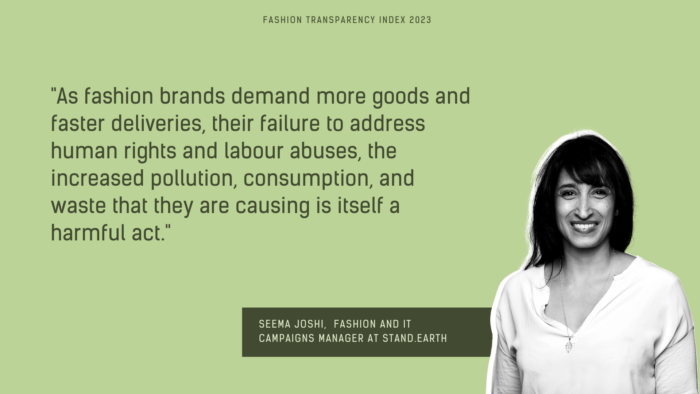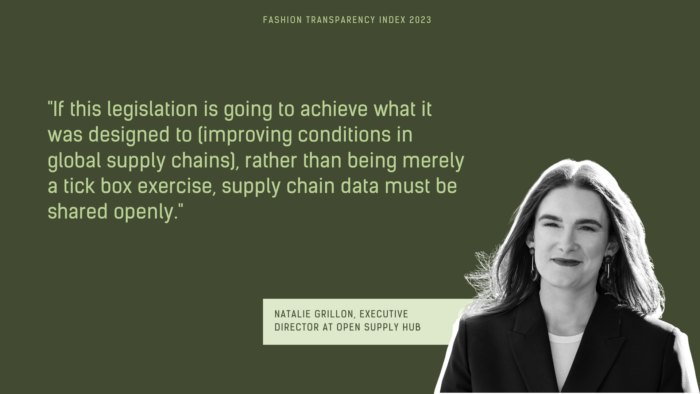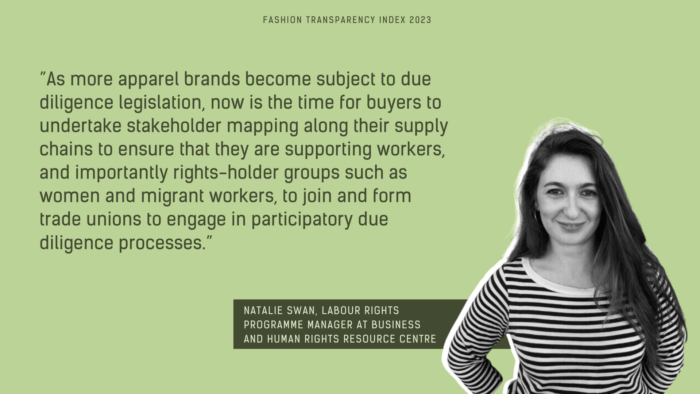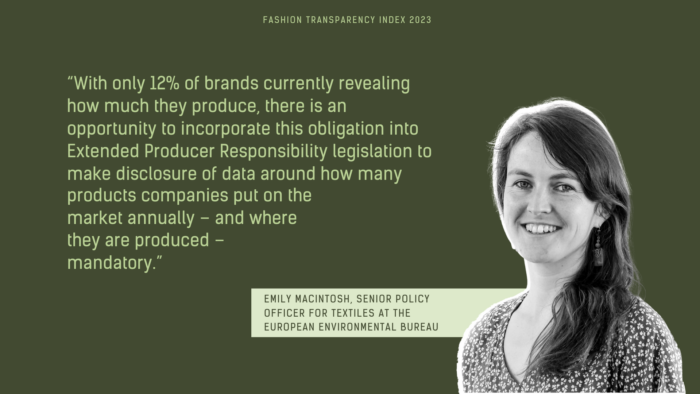The Regulatory Reckoning: Experts discuss the need for legislation
The fashion industry is set to face a wave of legislation across the EU and worldwide as governments finally begin acting on brands’ false sustainability claims, environmental destruction and human rights abuses. In the era of rampant greenwashing and worsening inequality, these policies are desperately needed.
Major fashion brands which sell to the EU – the largest importer of clothes in the world – are preparing to be legally required to disclose their due diligence procedures. It’s therefore no surprise that brands ranked in the Fashion Transparency Index collectively score higher on every indicator in human rights and environmental due diligence, compared to last year.
More brands than ever are disclosing their approach to due diligence; how affected stakeholders are consulted; salient risks identified; and which steps are taken to address these risks and the outcomes, in both their human rights and environmental due diligence. Upcoming legislation on due diligence, including the Corporate Sustainability Due Diligence Directive (CSDDD) and the Corporate Sustainability Reporting Directive (CSRD) at EU level have contributed to this uplift, as have similar efforts in Japan, Germany, the US and more.
But it’s not all good news. Major fashion brands remain far stronger at describing their identified risks, socially and environmentally, than the outcomes and impacts of due diligence. Transparency of the due diligence processes is foundational – but it is vital that brands also disclose its impacts and outcomes too. Transparency on how brands deliver on their commitments is the bare minimum that we can expect and yet, many brands are still reluctant to do so until they are legally mandated to do so – which, with upcoming legislation, will hopefully be very soon.
To delve deeper into this topic, we invited a range of industry experts and policymakers to provide their perspectives on the need for greater transparency and stringent legislation to tackle the fashion industry’s most pressing issues. Here, you can explore some viewpoints featured in the Fashion Transparency Index 2023.

THE FASHION INDUSTRY SHOULD DO NO HARM
Seema Joshi, Fashion and IT Campaigns Director, STAND.EARTH
The fashion industry is facing growing scrutiny to ‘do no harm.’ As a top global emitter, the fashion industry has a responsibility to take proportionate, proactive steps to prevent, identify and address harmful human, environmental and climate impacts originating from its factories and supply chain. Despite this outsized responsibility, according to this year’s Index findings, just 22% of brands disclose the outcomes of steps taken to address environmental issues identified as part of their environmental due diligence and even less (20%) disclose the outcomes of their human rights due diligence.
It’s no coincidence that the places where many fashion brands are offshoring the vast majority of their manufacturing are under-resourced areas in the Global South – where human rights and environmental protections are often poorly enforced, and companies can cheaply export the products and profits back to western countries. As fashion brands demand more goods and faster deliveries, their failure to address human rights and labour abuses, the increased pollution, consumption, and waste that they are causing is itself a harmful act.
Legal action, coupled with emerging regulations in Europe and North America, shows the importance of industry actors being able to prove that they have acted responsibly at all levels of production. The Fashion Revolution’s Transparency Index is an invaluable industry benchmark, which companies can use to show that they have taken the right steps and complied with relevant laws and international standards. This, in return, could protect them against accusations of poor behaviour.

“As the wave of supply chain due diligence and reporting legislation being enacted globally continues to grow, the resulting increase in the volume of apparel brands and retailers choosing to share their supplier data on Open Supply Hub is notable – and encouraging. If this legislation is going to achieve what it was designed to (improving conditions in global supply chains), rather than being merely a tick box exercise, supply chain data must be shared openly, and in a format that enables organisations to work with it practically and efficiently – machine readable, and available for download as an Excel or CSV file. In turn, this will accelerate opportunities for collaboration, as organisations are quickly able to identify shared connections at global production sites. We applaud the brands who have moved ahead of the curve to do just that.”
Natalie Grillon, Executive Director, Open Supply Hub

SLOW PROGRESS AND THE TICKING CLOCK OF CHANGE
Urska Trunk, Campaign Manager, Changing Markets Foundation
In the realm of fashion, governments around the world are promising to finally regulate an industry long plagued by unsustainable practices. A wave of approaching legislation should serve as a wake-up call for the fashion industry that prioritising genuine sustainability is no longer optional but necessary.
However, according to this year’s Fashion Transparency Index data, it is as if the fashion industry missed the memo. The progress on transparency and sustainable practices are frustratingly slow, suggesting that many brands might be just paying lip service to green practices and will eventually find themselves left behind in the aftermath of the regulatory storm. In an industry that claims to prioritise ethical and responsible practices, it should be commonplace for brands to openly share information about the types of fibres they use. This transparency serves as the foundation for building trust and fostering responsible consumption. Yet over two thirds (71%) of brands are still tiptoeing around the issue and failing to disclose the percentage or tonnes of fibres used.
While 51% of brands have disclosed sustainable materials strategy, roadmap, or targets, a glaring disparity emerges when compared to the mere 27% of brands actively reporting progress on reducing reliance on virgin fossil fuel-based fibres. This raises a critical question: can a sustainable materials strategy truly exist without addressing the need to reduce both virgin and recycled synthetic materials?
The industry’s selective approach to sustainability that conveniently ignores the link between synthetics and the destructive model of fast fashion, reeks of greenwashing. Despite the European Commission’s EU strategy for sustainable textiles highlighting this connection, the industry continues to turn a blind eye. Shockingly, our research from 2022 revealed that a quarter of major fashion companies increased their reliance on fossil-fuel-derived fibres during the climate emergency. Moreover, our greenwash.com website reveals that brands’ main sustainability materials strategy involves making clothes from plastic bottles; a false solution, as these items are much more likely to end up in landfill than if they were recycled to bottles.
Furthermore, brands are also reluctant to confront overproduction and microplastic pollution. A mere 12% of fashion companies, down from 15% the previous year, disclose the quantity of products produced annually. Most disappointingly, as studies continue to shed light on the devastating environmental and human health impacts of microplastics, less than a quarter of brands (22%, down from 24% last year) disclose what they are doing to minimise the impact of microfibres. This discrepancy between grandiose sustainability claims and sluggish progress on these crucial issues, lays bare the dark side of greenwashing.
In a decade since the tragic Rana Plaza incident, the slow progress in the industry is disheartening. However, upcoming legislation offers hope for reshaping the landscape, increasing clothing sustainability, and holding brands accountable. It will deliver a blow to insidious greenwashing tactics and require substantial evidence for sustainability claims. This will restore trust, empower consumers, and encourage genuine sustainability practices, leaving behind the days of vague claims and empty promises.

“The fast fashion model that exploits both people and the planet’s finite resources must come to an end. The welfare of people and the planet takes precedence over the textile industry’s pursuit of profits. Textile supply chains show that human rights and environmental consequences cross borders and our responsibility is global. Many voluntary measures and commitments by companies have taken an important step in the right direction, but the reality shows that these are far from enough. We as the EU must lead by example and ensure that the textiles sold in our shops guarantee high environmental and human
rights standards. To achieve this we need binding legislation. That’s why I call for European legislation that guarantees that fashion is not produced at the cost of environmental destruction and human lives. As rapporteur in the Environment Committee for sustainable textiles, I am fighting for this!”
Delara Burkhardt, Member of European Parliament, The Progressive Alliance of Socialists and Democrats
You can read more about upcoming legislation and how brands are responding to this change in the 2023 edition of the Fashion Transparency Index.
Header photo by Wesley Tingey on Unsplash








